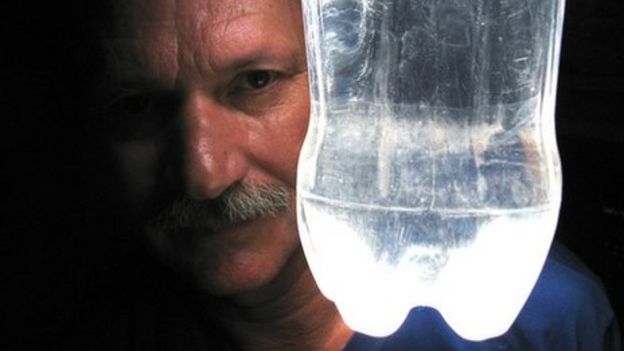
Alfredo Moser's invention is lighting up the world. In 2002, the Brazilian mechanic had a light-bulb moment and came up with a way of illuminating his house during the day without electricity - using nothing more than plastic bottles filled with water and a tiny bit of bleach.
In the last two years his innovation has spread throughout the world. It is expected to be in one million homes by early next year.
So how does it work? Simple refraction of sunlight, explains Moser, as he fills an empty two-litre plastic bottle.
"Add two capfuls of bleach to protect the water so it doesn't turn green [with algae]. The cleaner the bottle, the better," he adds.
Wrapping his face in a cloth he makes a hole in a roof tile with a drill. Then, from the bottom upwards, he pushes the bottle into the newly-made hole.
"You fix the bottle in with polyester resin. Even when it rains, the roof never leaks - not one drop."
The inspiration for the "Moser lamp" came to him during one of the country's frequent electricity blackouts in 2002. "The only places that had energy were the factories - not people's houses," he says, talking about the city where he lives, Uberaba, in southern Brazil.
Moser and his friends began to wonder how they would raise the alarm, in case of an emergency, such as a small plane coming down, imagining a situation in which they had no matches.
His boss at the time suggested getting a discarded plastic bottle, filling it with water and using it as a lens to focus the sun's rays on dry grass. That way one could start a fire, as a signal to rescuers. This idea stuck in Moser's head - he started playing around, filling up bottles and making circles of refracted light.
Soon he had developed the lamp.
"I didn't make any design drawings," he says.
"It's a divine light. God gave the sun to everyone, and light is for everyone. Whoever wants it saves money. You can't get an electric shock from it, and it doesn't cost a penny."
read more

No comments:
Post a Comment